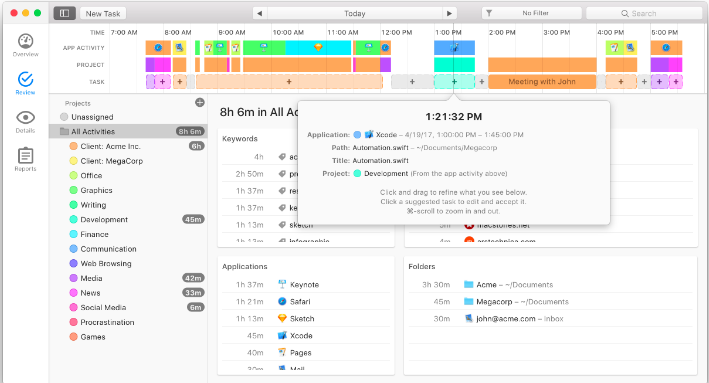3 Mistakes You’re Making When Tracking Time (and How to Fix Them)
![]()
Chances are that if you’re a freelancer or business owner, you are all too familiar with the practice of tracking your time.
Whether it’s necessary to properly bill clients or is just a good habit developed out of the desire to be more productive, you already know that the minimal time it actually takes to track time (especially if you take advantage of helpful tools, hint hint) is well worth the payoff.
And, if you work in an office environment and haven’t been required to track your time yet, get ready—it’s probably coming soon.
That’s why it’s important to understand how to properly track time and avoid some common mistakes.
Why Time Tracking is Important
There are a few different segments of time trackers, so the benefits for each group vary a bit. However, the gist remains consistent across users—it’s valuable to know how much time you are spending on different activities and tasks throughout the day so you can work smarter.
First, let’s break down three of the most common groups of time trackers:
Freelancers / Self-Employed
This is probably the most active group of time trackers, solely because keeping track of time is likely critical to one’s income.
Freelancers and small business owners need to know exactly how much time they are spending working on different tasks throughout the day—whether that’s researching for an upcoming presentation, crunching numbers, or building out a social media strategy—so they can accurately bill clients. Failure to do this can land you in two different situations, the most common of which is losing out on billable time (those 10 minutes here, 15 minutes there can add up quickly). On the other hand, you’d never want to be faced with having to defend the amount of work you’ve done if (gasp!) a client feels you haven’t delivered and asks to see proof.
Even if you’re on retainer, submitting weekly or monthly reports charting time spent on a client’s project helps you to continue to demonstrate your value and allows you to make a fair argument in the event that the time spent on the client consistently outweighs the agreed-upon compensation.
Overachievers
We mean this label in the most flattering of ways! And, to be fair, we should really just call this group “Average Achievers,” since being dedicated to productivity should be the norm.
If this sounds like you, tracking time might not necessarily directly equate to cash in your pocket. Instead, you might be concerned with getting the very most out of the day’s 24 hours—both within and outside of work times.
For example, a dedicated Mac power user who is interested in getting the maximum out of their device could be interested in what apps they use the most—and particularly what shortcuts and timesavers they could be utilizing.
For this group, having time-awareness (and self-awareness) empowers them to be as constructive as possible in today’s modern digital world.
Employees / Employers

In an effort to become more efficient (after all, time equals money), many companies are looking for ways to streamline productivity and ensure that an employee is spending the majority of their time on the primary duties of their position.
It’s less about looking over an employee’s shoulder, and more about doing what they can as a company to remove unnecessary disruptions and time-sucks.
According to Workfront’s 2017-2018 State of Enterprise Work Report, only 44% of the average U.S. worker’s work week is taken up by performing the primary duties of their job—that’s over half of the week being spent on wasteful meetings, emails, administrative tasks, and other interruptions.
By tracking time, employers are able to protect their employees’ time, all while helping their business to be as profitable as possible.
Common Time Tracking Blunders
Now that we covered how essential it is to track time, let’s touch on a few of the most common mistakes made while doing it.
Problem: Manual Tracking
Picture this: You sit down to tackle a project (writing a helpful blog on time tracking, perhaps?), and right before your fingers start to hit the keys, you click “start” within the stopwatch feature of your Mac’s Timer app.
You outline some ideas, do some initial research, then ring, ring—your boss is calling to discuss an important client proposal for next week. Some time passes (was it 20 minutes, or 35?) and as you settle back into your article you realize the timer has been going all along.
Or, even worse, you come back to reality after an hours-long typing daze to realize you never even started the timer to begin with—$%#!
Solution
Listen, you have more to worry about during the day than remembering to hit “start” and “stop” on a digital stopwatch. Using an automated time tracking tool like Timing takes the guessing work (and potential for human error) out of time tracking.
Using automated tools takes the guessing work (and potential for human error) out of time tracking. Share on XAnd, of course, not every single thing you do during the day is on a specific device. Having the ability to manually track (for calls, meetings, field work, etc.) within an automated tracking tool will greatly help you get a holistic sense of your time. (Timing offers this, too!)
Problem: Not Prioritizing
You know that time tracking is good for you, but sometimes it can feel like yet another thing on your endless to-do list for the day—so you put it off. You know what else that’s called? Procrastination.
“I’ll do it first thing tomorrow” or “I’ll just look at everything at the end of the week” can easily become familiar excuses. However, like anything else, a task that can take you just minutes while information is fresh in your head can take you exponentially longer if you leave it for later.
When you’re not taking a daily assessment of your day, it’s easier for time (read: billable minutes!) to fall through the cracks.
Solution

Make sure you use an automated (because manual tracking is problematic, remember?) tracking tool with easy-to-use features that quickly capture your day. With Timing, clicking the ‘Review’ tab will break down a timeline of minutes spent on your Mac into three groups: app activity, project, and task. It’s simple to personalize, color code, and drag relevant activities into corresponding projects.
Taking a couple minutes at the end of each day to review and organize your time can make a world of difference and save you hours in the future!
To learn more about Timing’s review capabilities, click here.
Problem: Wrong Tools
“Wrong” may be a harsh word here, because if you are understanding the importance of time tracking enough to be using a tool to help you do so, then you are already doing something right.
However, just like with most aides we use, time tracking is not a one-size-fits-all scenario. In order to make the process as simple and effective as possible, you need to weigh your personal needs against the features of a particular tool.
Some automated time tracking tools are meant for specific operating systems or devices (long live the Mac!); some are best suited for large corporations who need to track eight hours a day for hundreds of employees; and some are perfect for the everyday freelancer.
Using the wrong tool for your individual circumstance could end up making you lose time.
Solution
Ask yourself a series of questions:
- On what devices do I need time tracking? Are there multiple? (Check our recent blog on Timing’s new ‘Sync’ feature.)
- Is it important that my time tracking app work seamlessly across all apps, documents, and websites?
- Do I need the ability to employ manual tracking alongside automated tracking for calls, meetings, etc.?
- Am I looking for a general sense of my time, or do I need to categorize into multiple folders?
- Will having an easy-to-read timeline help me stay organized?
- How about a drag-and-drop feature?
- What am I going to do with this data? Do I need help generating reports?
You get the idea. Making a list of your must-haves will help you evaluate available tools with a more critical eye, allowing you to select the product that best fits your unique needs.
The Bottom Line
Time tracking tools can help you simplify your life by cutting down on the actual time spent time tracking, and allowing you to realize where and when you are most productive.
But, in the end, you must enlist the right tool with features that fit your situation to really get the most out of time tracking. And of course, you must still invest a small amount of time to ensure your time tracking is smooth and organized—a couple minutes now could save you a time-tracking headache down the road!
